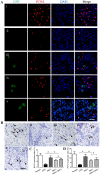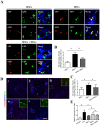In vivo tracking and comparison of the therapeutic effects of MSCs and HSCs for liver injury
- PMID: 23638052
- PMCID: PMC3640058
- DOI: 10.1371/journal.pone.0062363
In vivo tracking and comparison of the therapeutic effects of MSCs and HSCs for liver injury
Abstract
Background: Mesenchymal stem cells (MSCs) and hematopoietic stem cells (HSCs) have been studied for damaged liver repair; however, the conclusions drawn regarding their homing capacity to the injured liver are conflicting. Besides, the relative utility and synergistic effects of these two cell types on the injured liver remain unclear.
Methodology/principal findings: MSCs, HSCs and the combination of both cells were obtained from the bone marrow of male mice expressing enhanced green fluorescent protein(EGFP)and injected into the female mice with or without liver fibrosis. The distribution of the stem cells, survival rates, liver function, hepatocyte regeneration, growth factors and cytokines of the recipient mice were analyzed. We found that the liver content of the EGFP-donor cells was significantly higher in the MSCs group than in the HSCs or MSCs+HSCs group. The survival rate for the MSCs group was significantly higher than that of the HSCs or MSCs+HSCs group; all surpassed the control group. After MSC-transplantation, the injured livers were maximally restored, with less collagen than the controls. The fibrotic areas had decreased to a lesser extent in the mice transplanted with HSCs or MSCs+HSCs. Compared with mice in the HSCs group, the mice that received MSCs had better improved liver function. MSCs exhibited more remarkable paracrine effects and immunomodulatory properties on hepatic stellate cells and native hepatocytes in the treatment of the liver pathology. Synergistic actions of MSCs and HSCs were most likely not observed because the stem cells in liver were detected mostly as single cells, and single MSCs are insufficient to provide a beneficial niche for HSCs.
Conclusions/significance: MSCs exhibited a greater homing capability for the injured liver and modulated fibrosis and inflammation more effectively than did HSCs. Synergistic effects of MSCs and HSCs were not observed in liver injury.
Conflict of interest statement
Figures






Similar articles
-
Recruitment of endogenous bone marrow mesenchymal stem cells towards injured liver.J Cell Mol Med. 2010 Jun;14(6B):1494-508. doi: 10.1111/j.1582-4934.2009.00912.x. Epub 2009 Sep 24. J Cell Mol Med. 2010. PMID: 19780871 Free PMC article.
-
Modification of MSCs with aHSCs-targeting peptide pPB for enhanced therapeutic efficacy in liver fibrosis.Biomaterials. 2025 Oct;321:123295. doi: 10.1016/j.biomaterials.2025.123295. Epub 2025 Mar 28. Biomaterials. 2025. PMID: 40188718
-
Mesenchymal stromal cells enhance the engraftment of hematopoietic stem cells in an autologous mouse transplantation model.Stem Cell Res Ther. 2015 Sep 7;6(1):165. doi: 10.1186/s13287-015-0155-5. Stem Cell Res Ther. 2015. PMID: 26345192 Free PMC article.
-
Mechanistic effects of mesenchymal and hematopoietic stem cells: New therapeutic targets in myocardial infarction.J Cell Biochem. 2018 Jul;119(7):5274-5286. doi: 10.1002/jcb.26637. Epub 2018 Mar 12. J Cell Biochem. 2018. PMID: 29266431 Review.
-
Mesenchymal stem cell therapy for cirrhosis: Present and future perspectives.World J Gastroenterol. 2015 Sep 28;21(36):10253-61. doi: 10.3748/wjg.v21.i36.10253. World J Gastroenterol. 2015. PMID: 26420953 Free PMC article. Review.
Cited by
-
The characteristics of activated portal fibroblasts/myofibroblasts in liver fibrosis.Differentiation. 2016 Sep;92(3):84-92. doi: 10.1016/j.diff.2016.07.001. Epub 2016 Aug 31. Differentiation. 2016. PMID: 27591095 Free PMC article. Review.
-
Stromal Derived Factor-1/CXCR4 Axis Involved in Bone Marrow Mesenchymal Stem Cells Recruitment to Injured Liver.Stem Cells Int. 2016;2016:8906945. doi: 10.1155/2016/8906945. Epub 2016 Jan 12. Stem Cells Int. 2016. PMID: 26880995 Free PMC article.
-
Effect of Timing and Complement Receptor Antagonism on Intragraft Recruitment and Protolerogenic Effects of Mesenchymal Stromal Cells in Murine Kidney Transplantation.Transplantation. 2019 Jun;103(6):1121-1130. doi: 10.1097/TP.0000000000002611. Transplantation. 2019. PMID: 30801518 Free PMC article.
-
Perspective of placenta derived mesenchymal stem cells in acute liver failure.Cell Biosci. 2020 May 24;10:71. doi: 10.1186/s13578-020-00433-z. eCollection 2020. Cell Biosci. 2020. PMID: 32483484 Free PMC article. Review.
-
Beneficial Effects of Human Mesenchymal Stromal Cells on Porcine Hepatocyte Viability and Albumin Secretion.J Immunol Res. 2018 Jan 11;2018:1078547. doi: 10.1155/2018/1078547. eCollection 2018. J Immunol Res. 2018. PMID: 29577046 Free PMC article.
References
-
- Peng L, Xie DY, Lin BL, Liu J, Zhu HP, et al. (2011) Autologous bone marrow mesenchymal stem cell transplantation in liver failure patients caused by hepatitis B: short-term and long-term outcomes. Hepatology 54: 820–828. - PubMed
-
- Yannaki E, Anagnostopoulos A, Kapetanos D, Xagorari A, Iordanidis F, et al. (2006) Lasting amelioration in the clinical course of decompensated alcoholic cirrhosis with boost infusions of mobilized peripheral blood stem cells. Exp Hematol 34: 1583–1587. - PubMed
-
- am Esch JS 2nd, Knoefel WT, Klein M, Ghodsizad A, Fuerst G, et al (2005) Portal application of autologous CD133+ bone marrow cells to the liver: a novel concept to support hepatic regeneration. Stem Cells 23: 463–470. - PubMed
-
- Houlihan DD, Newsome PN (2008) Critical review of clinical trials of bone marrow stem cells in liver disease. Gastroenterology 135: 438–450. - PubMed
-
- Zhao Q, Ren H, Zhu D, Han Z (2009) Stem/progenitor cells in liver injury repair and regeneration. Biol Cell 101: 557–571. - PubMed
Publication types
MeSH terms
Substances
LinkOut - more resources
Full Text Sources
Other Literature Sources
Medical

